Psychiatric Mental Health Nursing Test Part 3 QUESTIONS AND ANSWERS 2021
Document Content and Description Below
1. A male adult client with bipolar disorder is being treated with lithium for the first time. Nurse Joy should observe the client for which common adverse effect of lithium? ▪ a. Sexual dysfunctio... n ▪ b. Constipation ▪ c. Polyuria ▪ d. Seizures Polyuria commonly occurs early in the treatment with lithium and could result in fluid volume deficit. Sexual dysfunction isn't a common adverse effect of lithium; it's more common with sedatives and tricyclic antidepressants. Diarrhea, not constipation, occurs with lithium.Constipation can occur with other psychiatric drugs, such as antipsychotic drugs. Seizures may be a later sign of lithium toxicity. 2. Mr. Velasquez is brought to the crisis intervention center by his wife, who states that he has been increasingly listless and less involved with his family recently. She reports that he sleeps poorly, eats little, and can barely perform basic self-care activities. She also reveals that 3 months ago he was in a car accident in which his best friend was killed. After the physician diagnoses acute depression, the nurse should anticipate administering: ▪ a. paroxetine (Paxil), 20 mg by mouth (P.O.) every morning ▪ b. amitriptyline (Elavil), 20 mg P.O. daily ▪ c. doxepin (Sinequan), 500 mg daily ▪ d. imipramine (Tofranil), 500 mg daily All of the drugs listed are antidepressants that may be prescribed for this client. However, paroxetine, 20 mg P.O. every morning, is the only correct dosage. Amitriptyline is usually started at 75 to 150 mg P.O. daily in divided doses. Doxepin is started at 25 to 50 mg daily and may be titrated upward to a maximum daily dose of 300 mg. Imipramine is started at 50 to 75 mg daily and, if tolerated, titrated upward to a maximum daily dose of 300 mg. 3. Nurse Vanessa is administering venlafaxine (Effexor) 75 mg by mouth daily to a client diagnosed with depression. What type of agent is venlafaxine? ▪ a. Monoamine oxidase inhibitor ▪ b. Tricyclic antidepressant ▪ c. Second-generation antidepressant ▪ d. Lithium derivative Physicians prescribe venlafaxine to treat depressive disorders; the drug is a second-generation antidepressant agent 4. At night, Victor a geriatric client with senile dementia wanders into other clients' rooms, awakening them. What is the best nursing intervention for dealing with the client's insomnia and nocturnal roaming? ▪ a. Administer a benzodiazepine at bedtime as prescribed ▪ b. Administer a phenothiazine at bedtime as prescribed ▪ c. Administer a barbiturate at bedtime as prescribed ▪ d. Lock the client's door at bedtime In geriatric clients, phenothiazines are preferred for sedation and thought clearing. Benzodiazepines usually are avoided because of the risk of addiction, cardiovascular complications, and impaired motor coordination. Barbiturates also are avoided because they may cause delirium, confusion, excitement, and addiction. Locking the door is inappropriate and would violate the client's rights. 5. Catherine has received treatment for depression for 3 weeks. Which behavior suggests that the client is recovering from depression? ▪ a. The client talks about the difficulties of returning to college after discharge ▪ b. The client spends most of the day sitting alone in the corner of the room. ▪ c. The client wears a hospital gown instead of street clothes. ▪ d. The client shows no emotion when visitors leave. By talking about returning to college, the client is demonstrating an interest in making plans for the future, which is a sign of recovery from depression. Decreased socialization, lack of interest in personal appearance, and lack of emotion are all symptoms of depression. 6. Nurse Mary Anne is caring for a client who has been diagnosed with hypochondriasis. The client attributes his cough to tuberculosis. A chest X-ray and skin test are negative for tuberculosis. The client begins to complain about the sudden onset of chest pain. How should the nurse react initially? ▪ a. Let the client know the nurse understands his fears of serious illness. ▪ b. Encourage the client to discuss his fear of having a serious illness. ▪ c. Report the complaint of chest pain to the physician. ▪ d. Determine if the illness is fulfilling a psychological need for the client. Because of the risk of missing an actual medical problem, any new symptoms reported by a client with hypochondriasis should be reported to the physician. The other interventions are appropriate after the nurse has determined that the client doesn't have a serious medical disorder. 7. Linda, a 54-year-old was found unconscious on the floor of her bathroom with self-inflicted wrist lacerations. An ambulance was called and the client was taken to the emergency department. When she was stable, the client was transferred to the inpatient psychiatric unit for observation and treatment with antidepressants. Now that the client is feeling better, which nursing intervention is most appropriate? ▪ a. Observe for extrapyramidal symptoms. ▪ b. Begin a therapeutic relationship. ▪ c. Cancel any no-suicide contracts. ▪ d. Continue suicide precautions As antidepressants begin to take effect and the client feels better, she may have the energy to initiate and complete another suicide attempt. As the client's energy level increases, the nurse must continue to be vigilant to the risk of suicide. Extrapyramidal symptoms may occur with antipsychotics and aren't adverse effects of antidepressants. A therapeutic relationship should be initiated upon admission to the psychiatric unit, after suicide precautions have been instituted. It's through this relationship that the client develops feelings of self-worth and trust and problem-solving takes place. In a no-suicide contract, the client states verbally or in writing that she won't attempt suicide and will seek out staff if she has suicidal thoughts. When the time period for a contract has expired, a new contract should be obtained from the client. 8. Which of the following statements should be included when teaching a male client about monoamine oxidase inhibitor (MAOI) antidepressants? ▪ a. Don't take prescribed or over-the-counter medications without consulting the physician. ▪ b. Avoid strenuous activity because of the cardiac effects of the drug. ▪ c. Have blood levels screened weekly for leukopenia. ▪ d. Don't take with aspirin or nonsteroidal anti-inflammatory drugs (NSAIDs). MAOI antidepressants when combined with a number of drugs can cause life-threatening hypertensive crisis. It's imperative that a client checks with his physician and pharmacist before taking any other medications. Activity doesn't need to be limited. Blood dyscrasias aren't a common problem with MAOIs. Aspirin and NSAIDs are safe to take with MAOIs. 9. Michael,a teenager was driving a car that slipped off an icy road, killing two of his friends. He repeatedly tells the nurse that he should be dead instead of his friends. The client's behavior is an example of: ▪ a. survivor's guilt ▪ b. denial ▪ c. anticipatory grief ▪ d. repression Individuals who survive a traumatic experience in which others have died commonly report powerful feelings of guilt that they survived and others didn't. This guilt is referred to as survivor's guilt. In denial, a person refuses to accept that a situation or feeling exists. Anticipatory grief occurs when an individual experiences grief before a loss occurs. In repression, an individual involuntarily blocks an unpleasant experience, memory, or feeling from consciousness. 10. Angelo with a diagnosis of major depression is prescribed clonazepam (Klonopin) for agitation in addition to an antidepressant. Client teaching would include which of the following statements? ▪ a. Klonopin may interact with organ meats. ▪ b. The medications shouldn't be taken together. ▪ c. Klonopin is a minor depressant and may aggravate symptoms of depression. ▪ d. The order needs to be clarified; call the physician. Klonopin is a central nervous system (CNS) depressant and can aggravate symptoms in depressed clients. It doesn't interact with organ meats and can be taken with antidepressant medication. There is no need to call the physician; the medications can be safely taken together. 11. A male client is about to be discharged with a prescription for the antipsychotic agent haloperidol (Haldol), 10 mg by mouth twice per day. During a discharge teaching session, nurse Ericka should provide which instruction to the client? ▪ a. Take the medication 1 hour before a meal. ▪ b. Decrease the dosage if signs of illness decrease. ▪ c. Apply a sunscreen before being exposed to the sun. ▪ d. Increase the dosage up to 50 mg twice per day if signs of illness don't decrease. Because haloperidol can cause photosensitivity and precipitate severe sunburn, the nurse should instruct the client to apply a sunscreen before exposure to the sun. The nurse also should teach the client to take haloperidol with meals — not 1 hour before — and should instruct the client not to decrease or increase the dosage unless the physician orders it. 12. For several years, a client with chronic schizophrenia has received 10 mg of fluphenazine hydrochloride (Prolixin) by mouth four times per day. Now the client has a temperature of 102° F (38.9° C), a heart rate of 120 beats/minute, a respiratory rate of 20 breaths/minute, and a blood pressure of 210/140 mm Hg. Because the client also is confused and incontinent, nurse Ronie suspects malignant neuroleptic syndrome. What steps should the nurse take? ▪ a. Give the next dose of fluphenazine, call the physician, and monitor vital signs. ▪ b. Withhold the next dose of fluphenazine, call the physician, and monitor vital signs. ▪ c. Give the next dose of fluphenazine and restrict the client to the room to decrease stimulation. ▪ d. Withhold the next dose of fluphenazine, administer an antipyretic agent, and increase the client's fluid intake. Malignant neuroleptic syndrome is a dangerous adverse effect of neuroleptic drugs such as fluphenazine. The nurse should withhold the next dose, notify the physician, and continue to monitor vital signs. Although an antipyretic agent may be used to reduce fever, increased fluid intake is contraindicated because it may increase the client's fluid volume further, raising blood pressure even higher. 13. During a group therapy session in the psychiatric unit, Joyce constantly interrupts with impulsive behavior and exaggerated stories that cast her as a hero or princess. She also manipulates the group with attention-seeking behaviors, such as sexual comments and angry outbursts. Nurse Joey realizes that these behaviors are typical of: ▪ a. paranoid personality disorder ▪ b. avoidant personality disorder ▪ c. histrionic personality disorder ▪ d. borderline personality disorder This client's behaviors are typical of histrionic personality disorder, which is marked by excessive emotionality and attention seeking. The client constantly seeks and demands attention, approval, or praise; may be seductive in behavior, appearance, or conversation; and is uncomfortable except when she is the center of attention. Typically, a client with paranoid personality disorder is suspicious, cold, hostile, and argumentative. Avoidant personality disorder is characterized by anxiety, fear, and social isolation. Borderline personality disorder is characterized by impulsive, unpredictable behavior and unstable, intense interpersonal relationships. 14. Nurse Jason is teaching a psychiatric client about her prescribed drugs, chlorpromazine and benztropine. Why is benztropine administered? ▪ a. To reduce psychotic symptoms ▪ b. To reduce extrapyramidal symptoms ▪ c. To control nausea and vomiting ▪ d. To relieve anxiety Benztropine is an anticholinergic medication, administered to reduce the extrapyramidal adverse effects of chlorpromazine and other antipsychotic medications. Benztropine doesn't reduce psychotic symptoms, relieve anxiety, or control nausea and vomiting. 15. Dr. Ryan would probably be ordered medication for the acutely aggressive schizophrenic client? ▪ a. chlorpromazine (Thorazine) ▪ b. haloperidol (Haldol) ▪ c. lithium carbonate (Lithonate) ▪ d. amitriptyline (Elavil) Haloperidol administered I.M. or I.V. is the drug of choice for acute aggressive psychotic behavior. Chlorpromazine is also an antipsychotic drug; however, it causes more pronounced sedation than haloperidol. Lithium carbonate is useful in bipolar or manic disorder, and amitriptyline is used for depression. 16. Joe is admitted to a psychiatric facility with a diagnosis of chronic schizophrenia. The history indicates that the client has been taking neuroleptic medication for many years. Assessment reveals unusual movements of the tongue, neck, and arms. Which condition should the nurse suspect? ▪ a. Tardive dyskinesia ▪ b. Dystonia ▪ c. Neuroleptic malignant syndrome ▪ d. Akathisia Unusual movements of the tongue, neck, and arms suggest tardive dyskinesia, an adverse reaction to neuroleptic medication. Dystonia is characterized by cramps and rigidity of the tongue, face, neck, and back muscles. Neuroleptic malignant syndrome causes rigidity, fever, hypertension, and diaphoresis. Akathisia causes restlessness, anxiety, and jitteriness. 17. Bryan, with a 5-year history of multiple psychiatric admissions is brought to the emergency department by the police. He was found wandering the streets disheveled, shoeless, and confused. Based on his previous medical records and current behavior, he is diagnosed with chronic undifferentiated schizophrenia. Nurse Tryzz should assign highest priority to which nursing diagnosis? ▪ a. Anxiety ▪ b. Impaired verbal communication ▪ c. Disturbed thought processes ▪ d. Self-care deficient: Dressing/grooming For this client, the highest-priority nursing diagnosis is Anxiety (severe to panic-level), manifested by the client's extreme withdrawal and attempt to protect himself from the environment. The nurse must act immediately to reduce anxiety and protect the client and others from possible injury. Impaired verbal communication, manifested by noncommunicativeness; Disturbed thought processes, evidenced by inability to understand the situation; and Self- care deficient: Dressing/grooming, evidenced by a disheveled appearance, are appropriate nursing diagnoses but aren't the highest priority. 18. Nurse Jeremiah formulates a nursing diagnosis of Impaired verbal communication for a client with schizotypal personality disorder. Based on this nursing diagnosis, which nursing intervention is most appropriate? ▪ a. Helping the client to participate in social interactions ▪ b. Establishing a one-on-one relationship with the client ▪ c. Establishing alternative forms of communication ▪ d. Allowing the client to decide when he wants to participate in verbal communication with the nurse By establishing a one-on-one relationship, the nurse helps the client learn how to interact with people in new situations. The other options are appropriate but should take place only after the nurse-client relationship is established. 19. Kris with schizophrenia is receiving antipsychotic medication. Which nursing diagnosis may be appropriate for this client? ▪ a. Ineffective protection related to blood dyscrasias ▪ b. Urinary frequency related to adverse effects of antipsychotic medication ▪ c. Risk for injury related to a severely decreased level of consciousness ▪ d. Risk for injury related to electrolyte disturbances Antipsychotic medications may cause neutropenia and granulocytopenia, life-threatening blood dyscrasias, that warrant a nursing diagnosis of Ineffective protection related to blood dyscrasias. These medications also have anticholinergic effects, such as urine retention, dry mouth, and constipation. Urinary frequency isn't an approved nursing diagnosis. Although antipsychotic medications may cause sedation, they don't severely decrease the level of consciousness, eliminating option C. These drugs don't cause electrolyte disturbances, eliminating option D. 20. Nurse Lea is providing care to a client with a catatonic type of schizophrenia who exhibits extreme negativism. To help the client meet his basic needs, the nurse should: ▪ a. ask the client which activity he would prefer to do first ▪ b. negotiate a time when the client will perform activities ▪ c. tell the client specifically and concisely what needs to be done ▪ d. prepare the client ahead of time for the activity The client needs to be informed of the activity and when it will be done. Giving the client choices isn't desirable because he can be manipulative or refuse to do anything. Negotiating and preparing the client ahead of time also isn't therapeutic with this type of client because he may not want to perform the activity. 21. Judah receiving haloperidol (Haldol) complains of a stiff jaw and difficulty swallowing. The nurse's first action is to: ▪ a. reassure the client and administer as needed lorazepam (Ativan) I.M. ▪ b. administer as needed dose of benztropine (Cogentin) I.M. as ordered. ▪ c. administer as needed dose of benztropine (Cogentin) by mouth as ordered. ▪ d. administer as needed dose of haloperidol (Haldol) by mouth. The client is most likely suffering from muscle rigidity due to haloperidol. I.M. benztropine should be administered to prevent asphyxia or aspiration. Lorazepam treats anxiety, not extrapyramidal effects. Another dose of haloperidol would increase the severity of the reaction. 22. Nurse Irma is aware that the most antipsychotic medications exert which of following effects on the central nervous system (CNS)? ▪ a. Stimulate the CNS by blocking postsynaptic dopamine, norepinephrine, and serotonin receptors. ▪ b. Sedate the CNS by stimulating serotonin at the synaptic cleft. ▪ c. Depress the CNS by blocking the postsynaptic transmission of dopamine, serotonin, and norepinephrine. ▪ d. Depress the CNS by stimulating the release of acetylcholine. The exact mechanism of antipsychotic medication action is unknown, but appear to depress the CNS by blocking the transmission of three neurotransmitters: dopamine, serotonin, and norepinephrine. They don't sedate the CNS by stimulating serotonin, and they don't stimulate neurotransmitter action or acetylcholine release. 23. Teresa with catatonic schizophrenia is mute, can't perform activities of daily living, and stares out the window for hours. What is the nurse's first priority? ▪ a. Assist the client with feeding. ▪ b. Assist the client with showering. ▪ c. Reassure the client about safety. ▪ d. Encourage socialization with peers. According to Maslow's hierarchy of needs, the need for food is among the most important. Other needs, in order of decreasing importance, include hygiene, safety, and a sense of belonging. 24. Aiza with paranoid schizophrenia has been experiencing auditory hallucinations for many years. One approach that has proven to be effective for hallucinating clients is to: ▪ a. take an as-needed dose of psychotropic medication whenever they hear voices. ▪ b. practice saying "Go away" or "Stop" when they hear voices. ▪ c. sing loudly to drown out the voices and provide a distraction. ▪ d. go to their room until the voices go away Researchers have found that some clients can learn to control bothersome hallucinations by telling the voices to go away or stop. Taking an as needed dose of psychotropic medication whenever the voices arise may lead to overmedication and put the client at risk for adverse effects. Because the voices aren't likely to go away permanently, the client must learn to deal with the hallucinations without relying on drugs. Although distraction is helpful, singing loudly may upset other clients and would be socially unacceptable after the client is discharged. Hallucinations are most bothersome in a quiet environment when the client is alone, so sending the client to his room would increase, rather than decrease, the hallucinations. 25. Nurse isabel is assigned to a client with catatonic schizophrenia. Which intervention should the nurse include in the client's plan of care? ▪ a. Meeting all of the client's physical needs ▪ b. Giving the client an opportunity to express concerns ▪ c. Administering lithium carbonate (Lithonate) as prescribed ▪ d. Providing a quiet environment where the client can be alone Because a client with catatonic schizophrenia can't meet physical needs independently, the nurse must provide for all of these needs, including adequate food and fluid intake, exercise, and elimination. This client is incapable of expressing concerns; however, the nurse should try to verbalize the message conveyed by the client's nonverbal behavior. Lithium is used to treat mania, not catatonic schizophrenia. Despite the client's mute, unresponsive state, the nurse should provide nonthreatening stimulation and should spend time with the client, not leave the client alone all the time. Although aware of the environment, the client doesn't interact with it actively; the nurse's support and presence can be reassuring. [Show More]
Last updated: 2 years ago
Preview 1 out of 8 pages

Buy this document to get the full access instantly
Instant Download Access after purchase
Buy NowInstant download
We Accept:

Reviews( 0 )
$15.00
Can't find what you want? Try our AI powered Search
Document information
Connected school, study & course
About the document
Uploaded On
Apr 25, 2021
Number of pages
8
Written in
Additional information
This document has been written for:
Uploaded
Apr 25, 2021
Downloads
0
Views
134


.png)
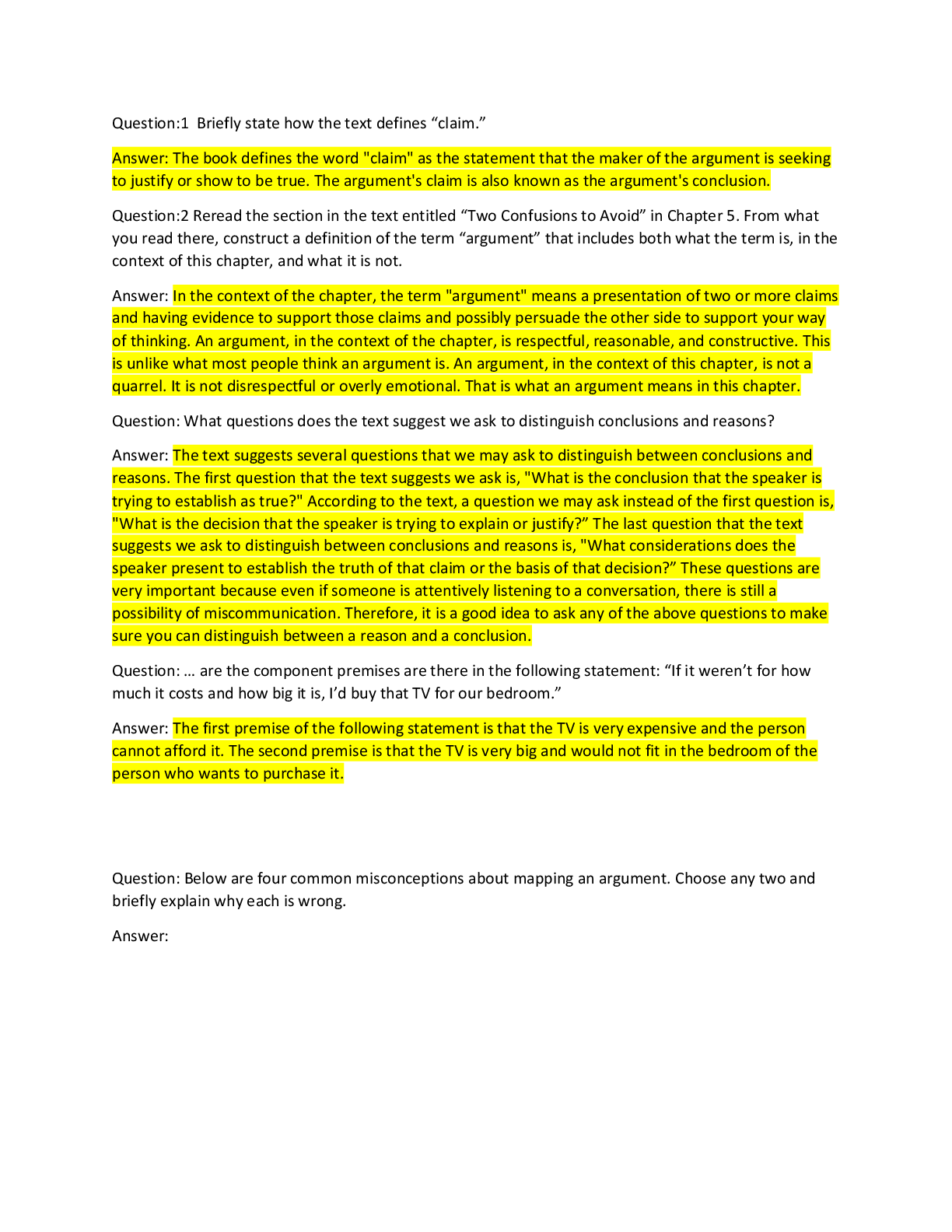
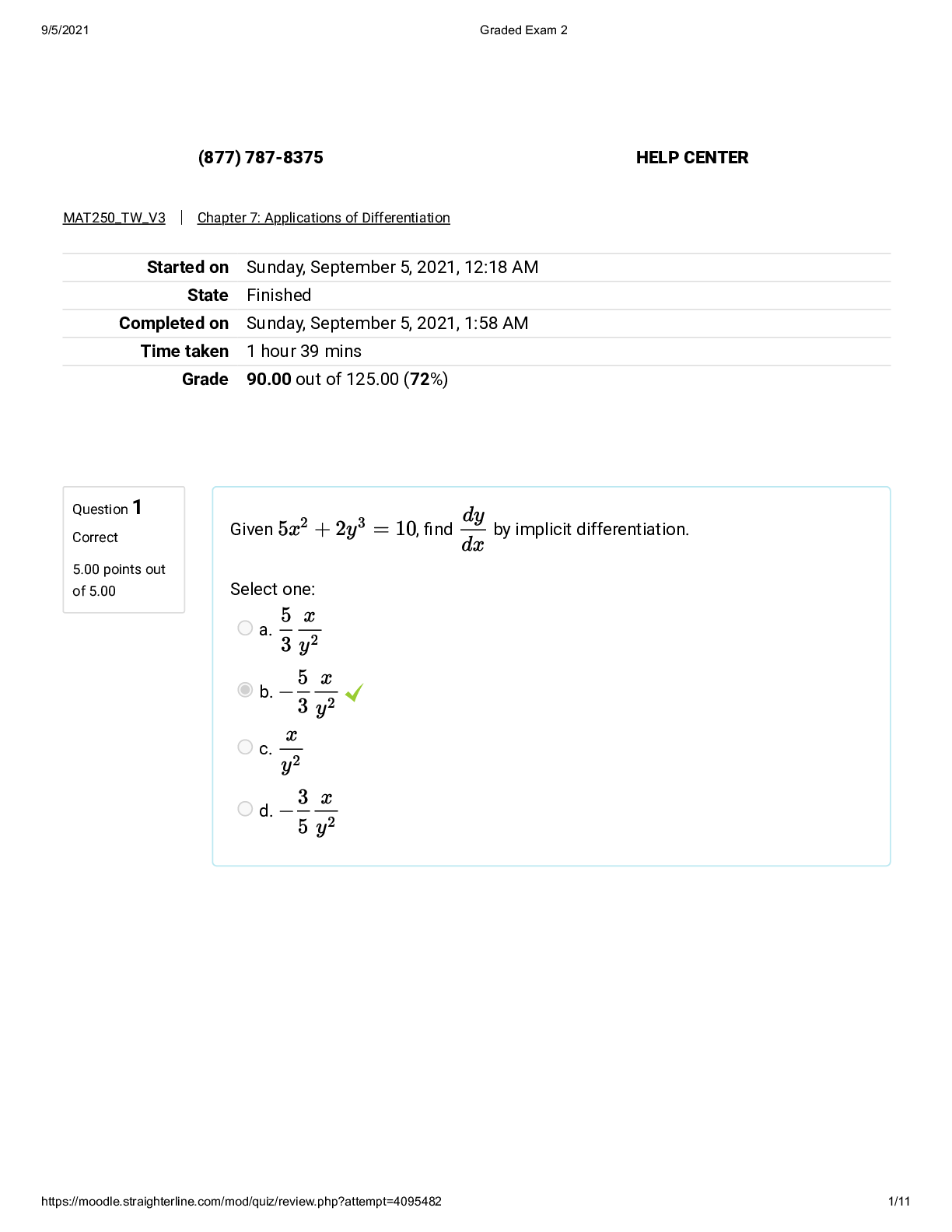
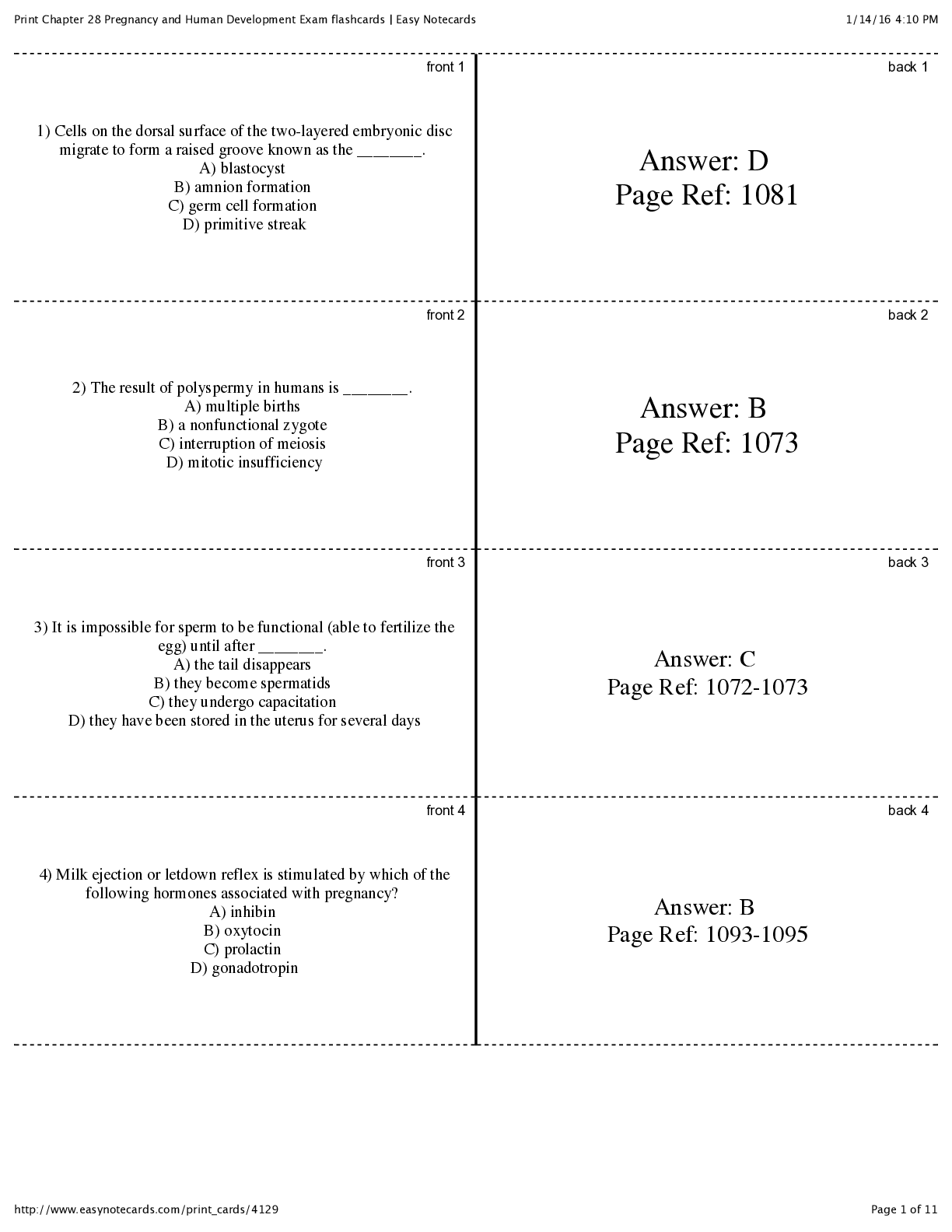
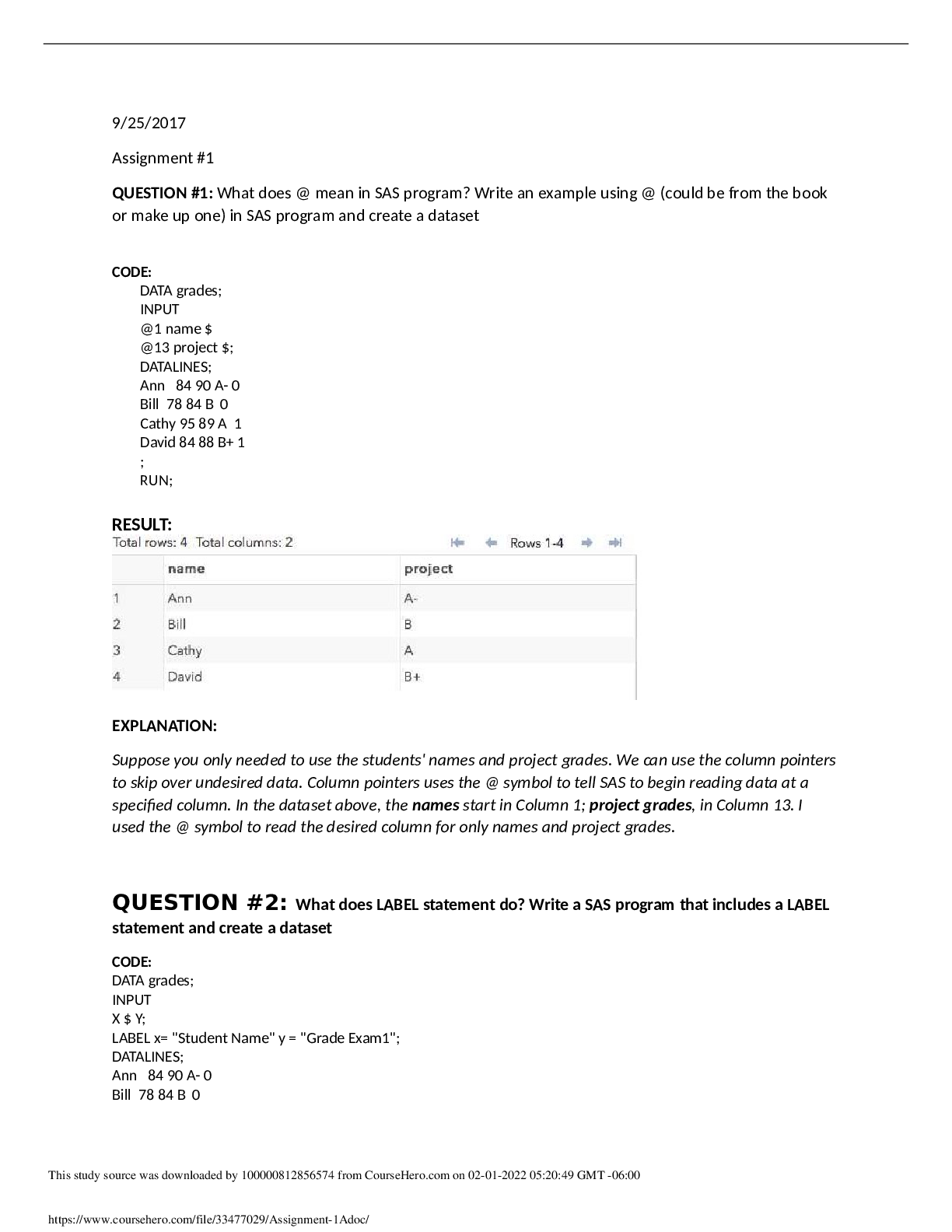

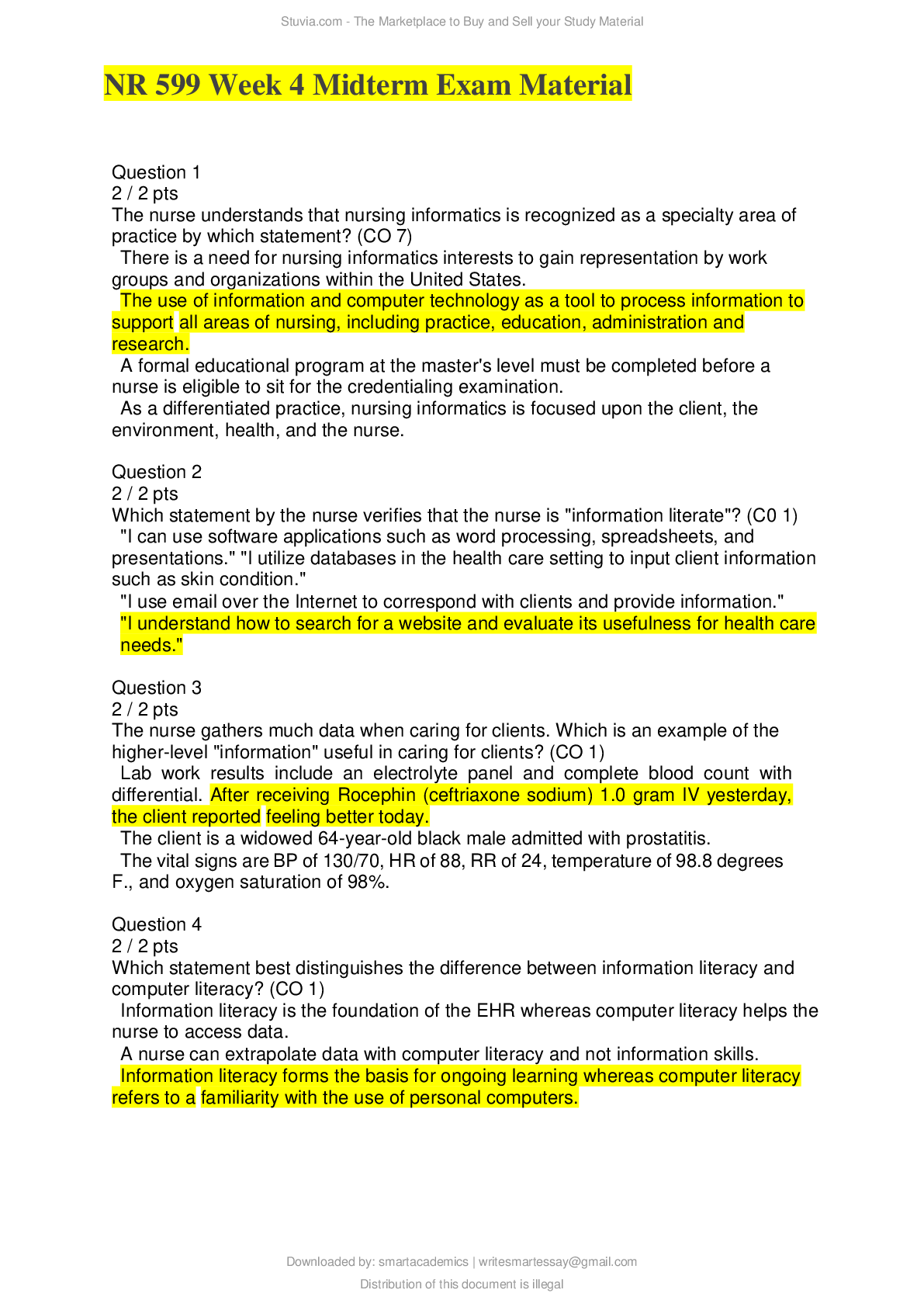
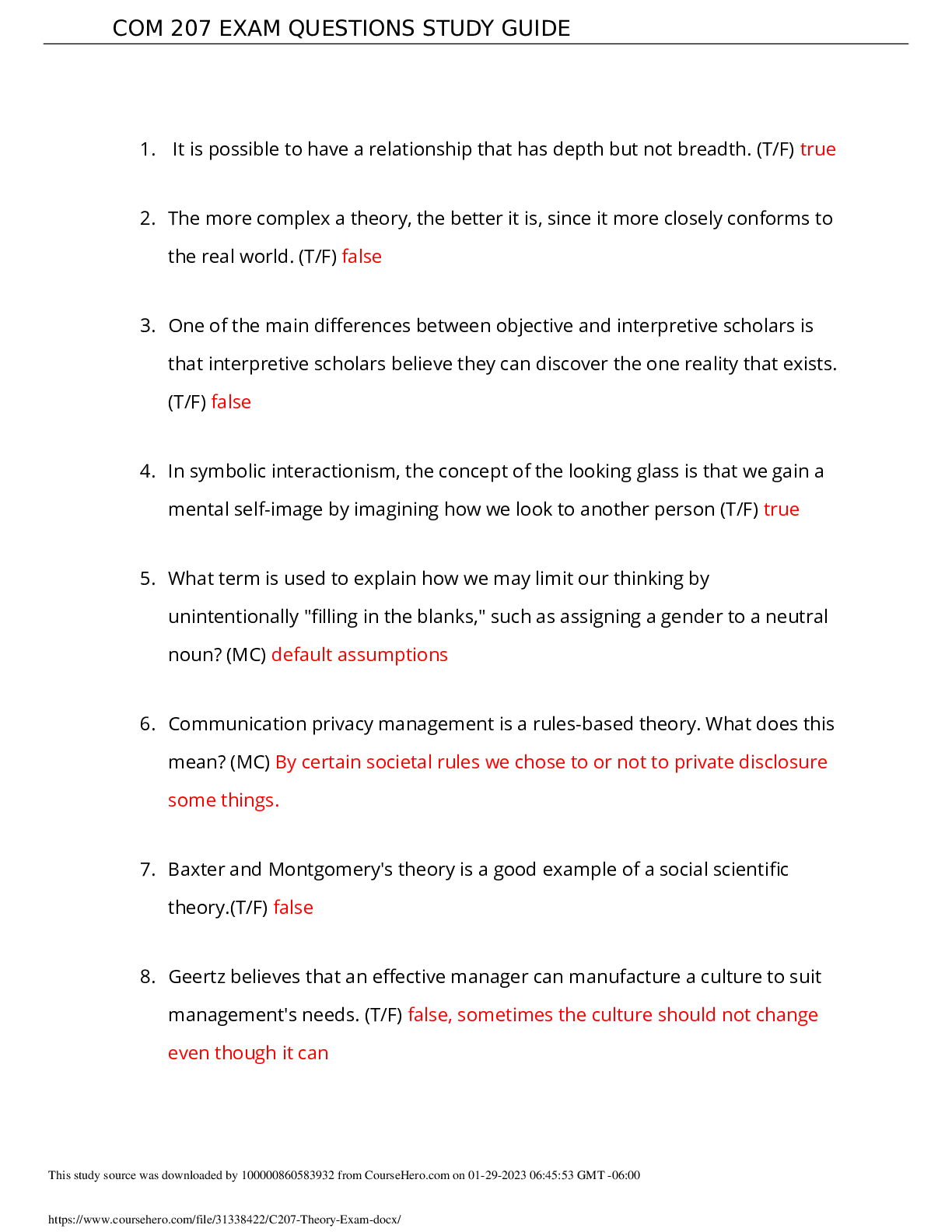
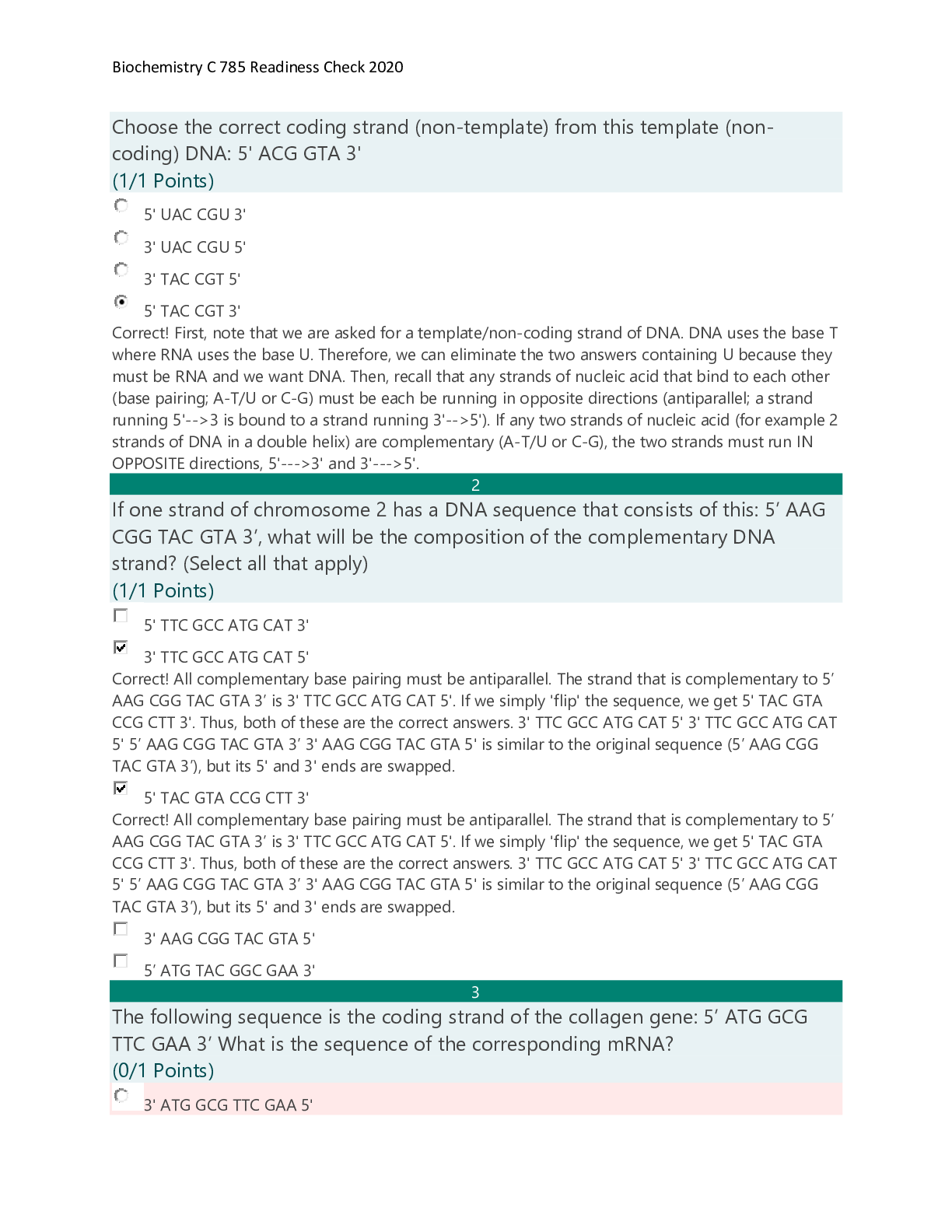
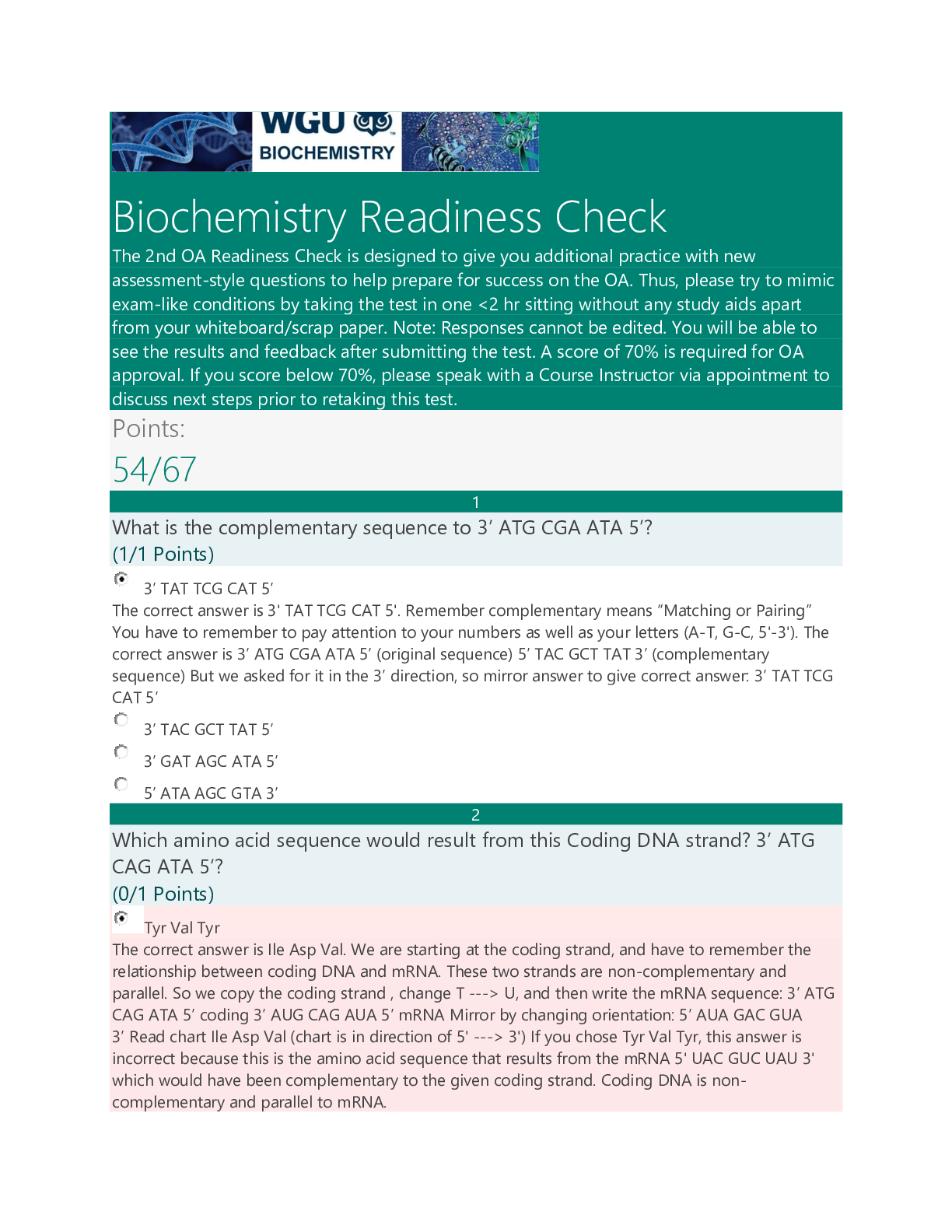

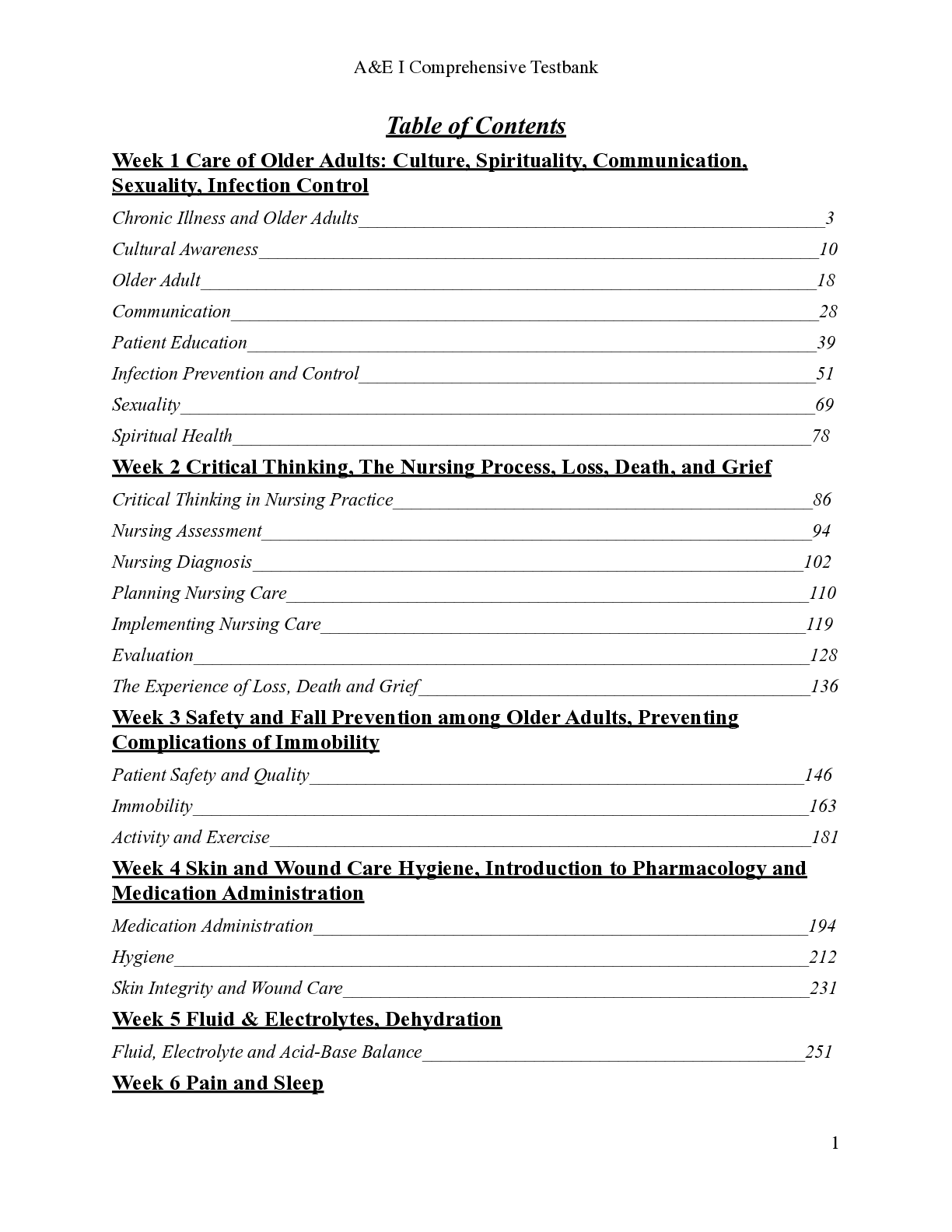


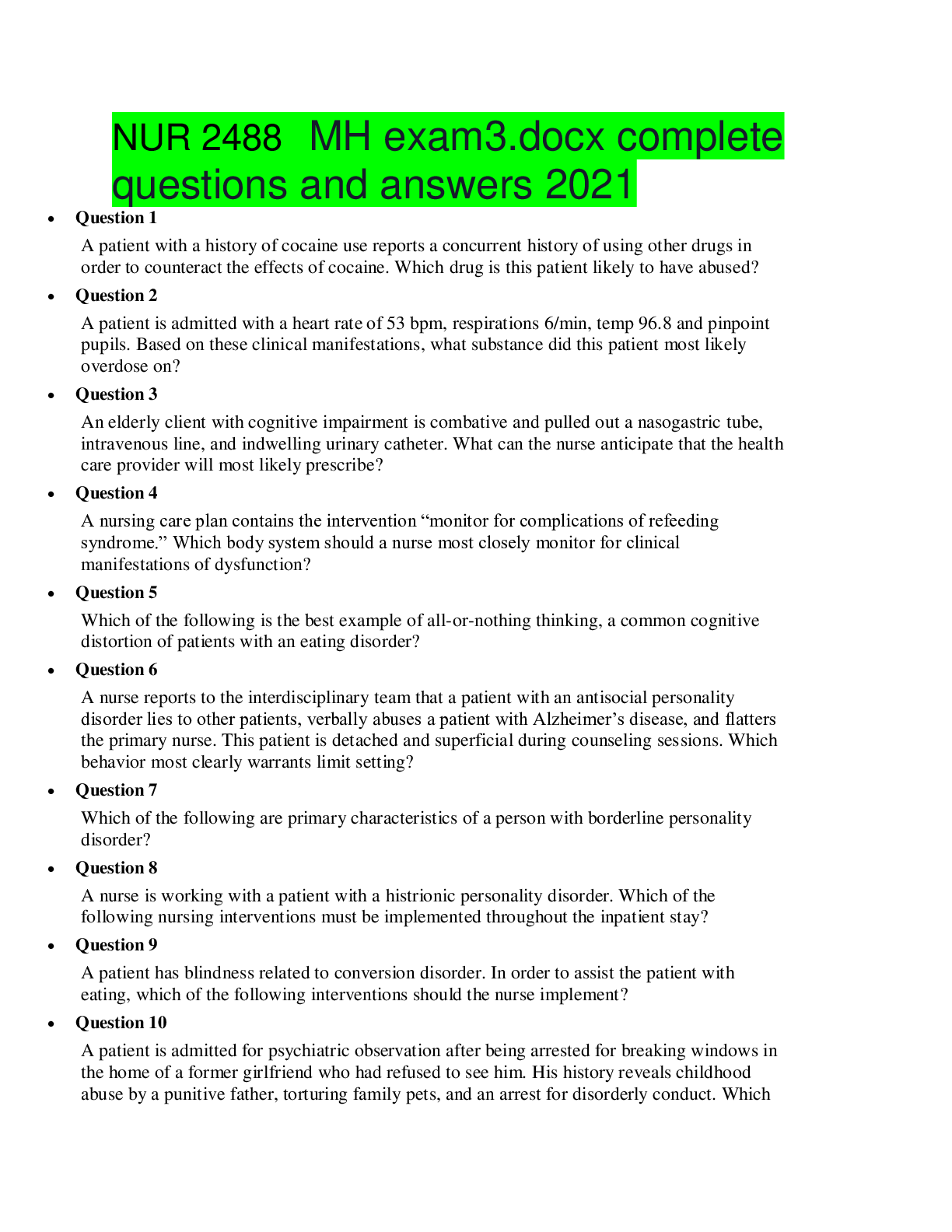






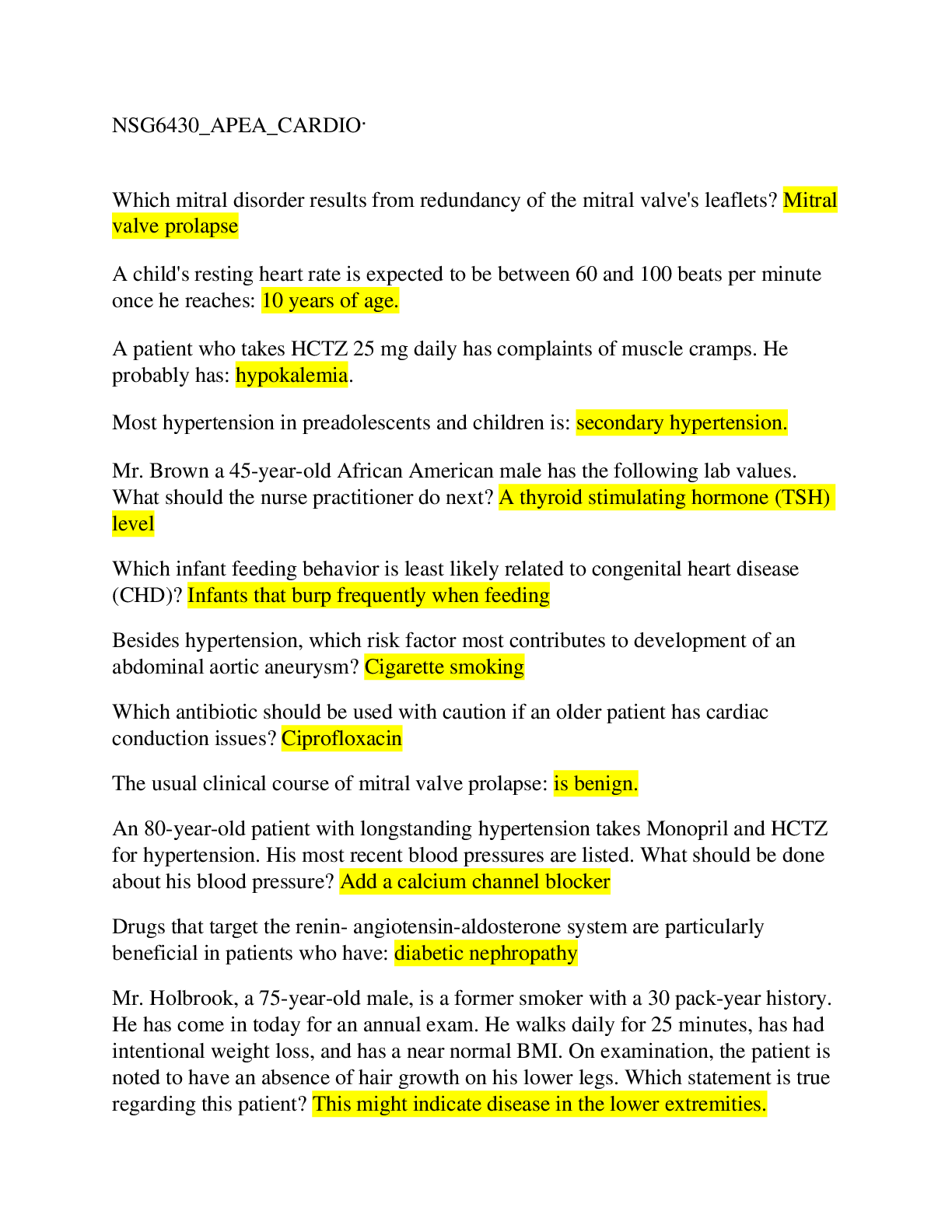
.png)

